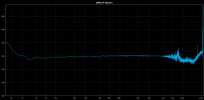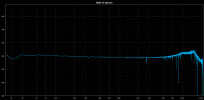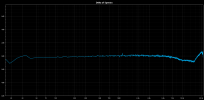I've heard good tube amps that sounded nice like SS. But they had beam-power tubes in push-pull ultra-linear, so obviously my hearing is defective 
-
WANTED: Happy members who like to discuss audio and other topics related to our interest. Desire to learn and share knowledge of science required. There are many reviews of audio hardware and expert members to help answer your questions. Click here to have your audio equipment measured for free!
You are using an out of date browser. It may not display this or other websites correctly.
You should upgrade or use an alternative browser.
You should upgrade or use an alternative browser.
Take the blind challenge! 300B SET vs. Straight Wire with Gain
- Thread starter GXAlan
- Start date
- Joined
- May 26, 2021
- Messages
- 512
- Likes
- 809
If the taps are properly placed on the primary winding, the linearity of the output section will be as good as the best triodes. But usually the taps are misplaced out of tradition, since in the old days that was done to get around a patent (which has long since expired).I've heard good tube amps that sounded nice like SS. But they had beam-power tubes in push-pull ultra-linear, so obviously my hearing is defective
The other tricky bit is how to apply feedback. Usually its applied to the cathode of an input tube, which causes the feedback to be distorted. It seems best to mix the feedback with the incoming signal in the way that its done with opamps, but of course no-one does that. As a result a lot of the 'sound' of such amps relies heavily on the linearity of the input tube...
I've seen designs that have nested feedback, back to the driver cathodes, as well as to the input. But I have no idea what this amp did. It was an expensive amp for the time (1970 or so) driving KLH Model 9s.If the taps are properly placed on the primary winding, the linearity of the output section will be as good as the best triodes. But usually the taps are misplaced out of tradition, since in the old days that was done to get around a patent (which has long since expired).
The other tricky bit is how to apply feedback. Usually its applied to the cathode of an input tube, which causes the feedback to be distorted. It seems best to mix the feedback with the incoming signal in the way that its done with opamps, but of course no-one does that. As a result a lot of the 'sound' of such amps relies heavily on the linearity of the input tube...
And they certainly don't normally listen like this: "I just chose a short segment and kept running shootouts over the same segment. "The vast majority of humans don't hear that well, so you should wonder.
Sgt. Ear Ache
Major Contributor
I tried this test with a good pair of earphones and made my choices of which I liked best. However, then I started wondering if I actually could tell the difference or if it was just self deception so I loaded Lacinato's ABX tester (which is great!) and tried again.
What I found was that my original ranking remained, particularly if I just chose a short segment and kept running shootouts over the same segment. Using the same segment, I was quite consistent, about 85%. With different segments each time it was about 70%. Now I'm very curious to see if I actually like the tube sound.
However, I was quite surprised at how similar the two versions sounded considering the seemingly huge difference in SINAD rankings. It does make me wonder about the claims of being able to clearly hear the difference between an amp with a SINAD at -76 and one at -86.
It makes me wonder about the claims of being able to hear the difference between cables, cable risers, speakers with 20 hours of "burn in" vs 60hrs, dacs, etc etc. lol
Still, we know that some people can hear to -300dbIt makes me wonder about the claims of being able to hear the difference between cables, cable risers, speakers with 20 hours of "burn in" vs 60hrs, dacs, etc etc. lol

DanielT
Major Contributor
Aha, interesting. Now I'm testing, via headphones. Regarding YES and their classic distorted guitar riff, to train my ears (is it cheating?) I'll compare and mix in the official YouTube video. That video lacks dynamics and snappiness, clarity compared to both 1 and 3 in the ones we are going to compare. That regardless if I change the volume. Of course, I can imagine this, but I don't think it's the case.
I will see if I can extrapolate what I experience with the YouTube video to test examples 1 and 3 and thus find out the difference. Then IF MORE distortion is added to something that is already recorded with distortion will it then be worse or better? Extra seasoning on a well-prepared dish by a good cook, roughly.
A matter of taste for sure (that is IF you can hear a difference).
That video. It simply doesn't sound good.
I will see if I can extrapolate what I experience with the YouTube video to test examples 1 and 3 and thus find out the difference. Then IF MORE distortion is added to something that is already recorded with distortion will it then be worse or better? Extra seasoning on a well-prepared dish by a good cook, roughly.
A matter of taste for sure (that is IF you can hear a difference).
That video. It simply doesn't sound good.
solderdude
Grand Contributor
Would depend on the design and above all the load would it not ?in particular an SET, is bass response, not high frequencies.
I think I do know what GBW is and what feedback does.. until someone can find a way to convince me feedback is a bad thing and open loop BW should always be at least 20kHz.To understand this, its helpful to understand what Gain Bandwidth Product is, and how that's important when dealing with an amplifier using feedback
That may well be so but the distortion would be substantial and will become lower when feedback is applied. Of course with BW limited components (transformers) that add distortion into the feedback loop it can go in all directions depending on the design.So when you graph distortion vs frequency, you get a flat line across the audio band
In the case of this amp I am quite sure people will have a hard time preferring the tube amp over the wire and vice versa. All people that reported talked about the treble roll-off as a give away. Remove that and only the distortion remains is my point.So this supposition is incorrect, unless the load in the highs for the SET is lower in impedance than it is in the midrange.
The amp in question, like many of these designs, are highly load dependent.
People may like/prefer that (depends on the speaker, amp, music and individual)
Not all people like to have the sound changed in some way.
Last edited:
Right? I kind of wanted a hi-fi, not a re-processing facility.Not all people like to have the sound changed in some way.
solderdude
Grand Contributor
Did the following thing:
Used @danadam level matched uploads, added an approximate of the treble + bass difference found by @pkane to the files that needed it and created ZIP files.
For those who like to hear the difference between the original and the SET amp without the subbass (-1dB) and treble (20kHz-4dB) roll-off, as that roll-off should be almost completely eliminated, leaving the added harmonics, IM, noise and hum as the only things that can differentiate the files.
Maybe @pkane can check if I did the job correctly ? My ears tell me I did but am just as prone to bias as the next person.
Used @danadam level matched uploads, added an approximate of the treble + bass difference found by @pkane to the files that needed it and created ZIP files.
For those who like to hear the difference between the original and the SET amp without the subbass (-1dB) and treble (20kHz-4dB) roll-off, as that roll-off should be almost completely eliminated, leaving the added harmonics, IM, noise and hum as the only things that can differentiate the files.
Maybe @pkane can check if I did the job correctly ? My ears tell me I did but am just as prone to bias as the next person.
Attachments
People set the listening volume to get the RMS (LUFS) level they want. They don't care about the peaks, in practice.When you make the RMS values equal, then the peaks are different and you might be able to hear the difference in the transient/impact.
So it makes more sense to align RMS levels, IMO.
This is very interesting !Fair Use Statement:
The copyrighted material is being used for research and scholarship. Less than 10% of the total length of each piece is used. Commercial recordings are required for this experiment to reflect the types of music that one would really listen.
Is that really enough ?
Could you link to some page that confirms that ?
Is that valid outside of US ?
That's been some time I wanted to do something similar, but the copyright topic was blocking me.
Thanks !
- Thread Starter
- #173
This is very interesting !
Is that really enough ?
Could you link to some page that confirms that ?
Is that valid outside of US ?
That's been some time I wanted to do something similar, but the copyright topic was blocking me.
Thanks !
It’s very complicated. It is only valid for the US.
There are four standards in US copyright law
U.S. Copyright Office Fair Use Index
The goal of the Index is to make the principles and application of fair use more accessible and understandable to the public by presenting a searchable database of court opinions, including by category and type of use (e.g., music, internet/digitization, parody).
Then there are years upon years of case law which set precedents that can be referenced and this document that is a reference of generally how you can provide details and context to the four standards.
You can be in violation if you used less than 10 seconds of something where your use violated the four principles. On the other hand, if you were using 31 seconds which goes against the recommendations/discussion in the USPTO website, but you didn’t violate the four principles, you would OK. In a legal battle, you would have to justify why you had to exceed the 10%/30 second threshold for your in-scope fair use.
Another nice summary/discussion.

Measuring Fair Use: The Four Factors
Unfortunately, the only way to get a definitive answer on whether a particular use is a fair use is to have it resolved in federal court. Judges use four factors to resolve fair use disputes, as ...
Did the following thing:
Used @danadam level matched uploads, added an approximate of the treble + bass difference found by @pkane to the files that needed it and created ZIP files.
For those who like to hear the difference between the original and the SET amp without the subbass (-1dB) and treble (20kHz-4dB) roll-off, as that roll-off should be almost completely eliminated, leaving the added harmonics, IM, noise and hum as the only things that can differentiate the files.
Maybe @pkane can check if I did the job correctly ? My ears tell me I did but am just as prone to bias as the next person.
Well done, @solderdude !
Set A:

Set B:

Set C:

I want the sound supplied to me 'as it is', i.e in high fidelity to source...so I can have my way with it.Right? I kind of wanted a hi-fi, not a re-processing facility.
I don't care if that's not 'hi fi'.
Last edited:
- Joined
- May 26, 2021
- Messages
- 512
- Likes
- 809
Would depend on the design and above all the load would it not ?
Yes and no: all SETs lack the LF response really needed to get the bass right. This normally is not a weakness since the speakers needed to work with them generally can't make bass either, unless they are very very large (IOW enormous horns...) and yes the load is important but in that context. If the load sensitive issues are not given attention you can't get the amp to really do what its meant to do. Keep in mind that the idea of voltage drive came in during the 1950s and SETs come from several decades earlier, when everything was done with power drive rather than voltage drive.
I think I do know what GBW is and what feedback does.. until someone can find a way to convince me feedback is a bad thing and open loop BW should always be at least 20kHz.
I'm not saying feedback is bad!! But it can have bad effects if poorly applied. Open Loop bandwidth will need to be a lot higher than 20Khz or else you'll need a ton of gain... your comment here about 20KHz is ambiguous- did you mean that to say unity gain or -3db or -0/5db??
I previously explained a common problem with feedback if the GBP is insufficient (and in most cases of amplifiers made, it is). Here's another: if the feedback is applied to a non-linear node (such as the base of a transistor in a differential pair or the cathode of an input tube) the feedback signal will be distorted by the non-linearity of the device. This in turn contributes to higher ordered harmonics, inharmonic distortions and IMD. These things are audible and are a very good reason why SETs are so annoyingly still around (since re-emerging in the 1990s). Norman Crowhust wrote about this a good 60 years ago so this should not be controversial in any way.
It is not my intention to derail this thread on this topic.
That may well be so but the distortion would be substantial and will become lower when feedback is applied. Of course with BW limited components (transformers) that add distortion into the feedback loop it can go in all directions depending on the design.
Yes the transformer is bandwidth limited, but the point of feedback is to deal with distortions at the output of the circuit and this of course includes that which an OPT might make (which, if properly loaded, will be fairly low). Perhaps you might want to retract this particular statement?
Again, its highly unlikely that the SET has an audible treble rolloff, unless you're saying that rolling off at 25-30KHz is going to be audible. Have you ever put an SET or for that matter, tube amplifier on the bench and measured bandwidth?? I get the load dependent issue but in tube amplifiers that was solved 60 years or more ago by the application of feedback so as to get voltage source operation out of the amp.In the case of this amp I am quite sure people will have a hard time preferring the tube amp over the wire and vice versa. All people that reported talked about the treble roll-off as a give away. Remove that and only the distortion remains is my point.
The amp in question, like many of these designs, are highly load dependent.
People may like/prefer that (depends on the speaker, amp, music and individual)
Not all people like to have the sound changed in some way.
Regarding the bandwidth thing again- many tube amplifiers are full power to 100KHz (H/K Citation 2 and Citation 5 for example). 50KHz is very common (Dynaco, Marantz, ARC and more). I'm just wondering why you think this would be audible in the treble range.
Again, the reason tube amplifiers seem to have less energy in the treble range is not due to a rolloff. Its due to how they make distortion as compared to how traditional solid state amps make distortion. This is easy to see in the measurements as I pointed out earlier.
W-E 91E 300B amp just arrived (and holy crap that thing is big!). It arrived in a steamer-trunk style crate. This will be interesting.
Unfortunately, I will not be able to divulge results until after the review (which will be written by Richard Honeycutt, I'm just doing measurements) appears. However, I'll be happy to share my personal sonic impressions after the review is out, and I'll see if I can get permission to post a recording of the output into an actual loudspeaker load versus the original source material.
Unfortunately, I will not be able to divulge results until after the review (which will be written by Richard Honeycutt, I'm just doing measurements) appears. However, I'll be happy to share my personal sonic impressions after the review is out, and I'll see if I can get permission to post a recording of the output into an actual loudspeaker load versus the original source material.
Is that the one that's "controversial" because it's not a conventional single-ended design?W-E 91E 300B amp just arrived (and holy crap that thing is big!). It arrived in a steamer-trunk style crate. This will be interesting.
Unfortunately, I will not be able to divulge results until after the review (which will be written by Richard Honeycutt, I'm just doing measurements) appears. However, I'll be happy to share my personal sonic impressions after the review is out, and I'll see if I can get permission to post a recording of the output into an actual loudspeaker load versus the original source material.
DanielT
Major Contributor
To get around the problems, challenges with tube amps and their inability to power bass drivers:Yes and no: all SETs lack the LF response really needed to get the bass right. This normally is not a weakness since the speakers needed to work with them generally can't make bass either, unless they are very very large (IOW enormous horns...) and yes the load is important but in that context. If the load sensitive issues are not given attention you can't get the amp to really do what its meant to do. Keep in mind that the idea of voltage drive came in during the 1950s and SETs come from several decades earlier, when everything was done with power drive rather than voltage drive.
I'm not saying feedback is bad!! But it can have bad effects if poorly applied. Open Loop bandwidth will need to be a lot higher than 20Khz or else you'll need a ton of gain... your comment here about 20KHz is ambiguous- did you mean that to say unity gain or -3db or -0/5db??
I previously explained a common problem with feedback if the GBP is insufficient (and in most cases of amplifiers made, it is). Here's another: if the feedback is applied to a non-linear node (such as the base of a transistor in a differential pair or the cathode of an input tube) the feedback signal will be distorted by the non-linearity of the device. This in turn contributes to higher ordered harmonics, inharmonic distortions and IMD. These things are audible and are a very good reason why SETs are so annoyingly still around (since re-emerging in the 1990s). Norman Crowhust wrote about this a good 60 years ago so this should not be controversial in any way.
It is not my intention to derail this thread on this topic.
Yes the transformer is bandwidth limited, but the point of feedback is to deal with distortions at the output of the circuit and this of course includes that which an OPT might make (which, if properly loaded, will be fairly low). Perhaps you might want to retract this particular statement?
Again, its highly unlikely that the SET has an audible treble rolloff, unless you're saying that rolling off at 25-30KHz is going to be audible. Have you ever put an SET or for that matter, tube amplifier on the bench and measured bandwidth?? I get the load dependent issue but in tube amplifiers that was solved 60 years or more ago by the application of feedback so as to get voltage source operation out of the amp.
Regarding the bandwidth thing again- many tube amplifiers are full power to 100KHz (H/K Citation 2 and Citation 5 for example). 50KHz is very common (Dynaco, Marantz, ARC and more). I'm just wondering why you think this would be audible in the treble range.
Again, the reason tube amplifiers seem to have less energy in the treble range is not due to a rolloff. Its due to how they make distortion as compared to how traditional solid state amps make distortion. This is easy to see in the measurements as I pointed out earlier.
A three-way speaker where you can plug in and drive the bass element /drivers with class D amplification, then drive the midrange woofer and tweeter with a tube amplifier. I don't understand why this solution is not more common, for those who now want a tube amp in their solution?
___
Another note. I filled out the survey now. It was interesting to see the other results. More discussion about it will hopefully come after May 4. That is after the voting has ended, that is.
Dimitri
Senior Member
My "standard" test track is Hotel California. The intro , up to "on a dark desert highway" (cut).
Using anything else I can express a "preference" but I don't have an opinion on which one is more "correct".
Correct of course according to the ears of yours truly
Using anything else I can express a "preference" but I don't have an opinion on which one is more "correct".
Correct of course according to the ears of yours truly
Similar threads
- Poll
- Replies
- 66
- Views
- 6K
- Poll
- Replies
- 47
- Views
- 13K
- Replies
- 8
- Views
- 3K
- Replies
- 4
- Views
- 4K
